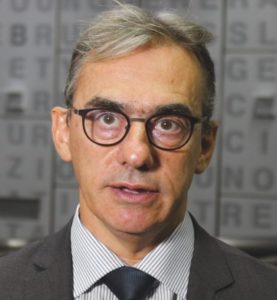
Marco Ventura is a professor with tenure in law and religion at the University of Siena and the Director of the Center for Religious Studies at Fondazione Bruno Kessler of Trento
Causing many religious activities to go online and resort to new information and communication technologies, the COVID-19 related lockdown and social distancing is transforming digital religion, a growing reality and research area for the last 20 years, into a mass experience. Quickly, the pre-pandemic niche experience and study is being replaced by a new reality and knowledge of digital religion, associated with controversies over conflicting interpretations of the process. Reacting to the transition into our pandemic-driven new age of digital religion, the four blogs gathered here contribute valuable information and present the many faces of the debate on how good or bad, digitalization of religion is (as well as on how actors should handle such momentous transformation).
In this attempt to briefly introduce the four texts and organize the extraordinary fluidity of digital religion in times of COVID-19, I would like to highlight four key elements of the reality, knowledge, and debate we are confronted with as we try to get ready for the new scenario.
First, digitalization of religion is neither proofof the decline of religion, nor proof of its rise, nor revenge. For how actors either could be tempted to embrace one opposite or the other, digital religion is both at the same time and thus, necessarily a post-secular religion, as Paolo Costa explains in his text.
Second, although Regina Elsner criticizes the absence of “a systematic and digitally visible socio-ethical discourse” (at least in the case of Catholic and Orthodox communities), digitalization of religion in the age of the pandemic amplifies the commitment of religious individuals and communities to sustainable development through the unique blend of materiality and immateriality that we experience in our age. In a world where the real and the virtual are bound to coexist, religion in the pandemic is proving at the same time to be the material religion of health care and humanitarian aid, and the immaterial religion of digital communication and online exchange.
Third, digital religion challenges the internal organisation of faith communities, as illustrated by disputes over the structuring of the authority, the possibility of truly sacred rituals online, the “priest-centered nature of the Church” (to put it in Elsner’s words), and defense of autonomy and freedom vis-à-vis governmental pressure.
Forth, digital religion is about religious diversity, interreligious exchange, mutual learning, and the opening the field of religion. Even a religious experience such as paganism (largely overlooked, if not rejected, by traditional, global faith communities) has a lot to teach. In the same vein, we learn from Regina Elsner about challenging analogies and differences in the digital reaction to the pandemic of European Catholics and the Orthodox.
While helping us identify the specific, unique challenge of digitalized religion in the age of the pandemic, the four authors also invite the reader to relativize change and see trends beyond the contingency. Pointing to what goes back to pre-pandemic practices and looking forward to what will stay after the emergency, Jennifer Lane underlines that “digital innovations will likely significantly change missionary work in the future” and that “the focus on a home-centered, Church-supported life of discipleship began before the pandemic and this focus on Church as integrated into our lives rather than something we experience at a certain time or place will continue even when we return to chapels for weekly Sunday meetings.”
Finally, in a debate polarized around good and bad change, secularized and resilient religion, Regina Elsner points to the ultimate divergence between those who accept change momentarily and defensively, and those who see this as a unique opportunity for believers to serve mankind. This would be the worst scenario, for Regina Elsner, “that digitalization was only a quick replacement and probably only about the self-preservation of existing church groups, rather than about a wider and sustainable outreach all over the world.”
Paolo Costa: Prisoners of an Image Secularization as an Epidemic
Regina Elsner: Digitalizing the Church? Different Contexts, Similar Theological Challenges in the Catholic and Orthodox Churches
Jennifer Lane: Global Church and Home Church in The Church of Jesus Christ of Latter-day Saints
